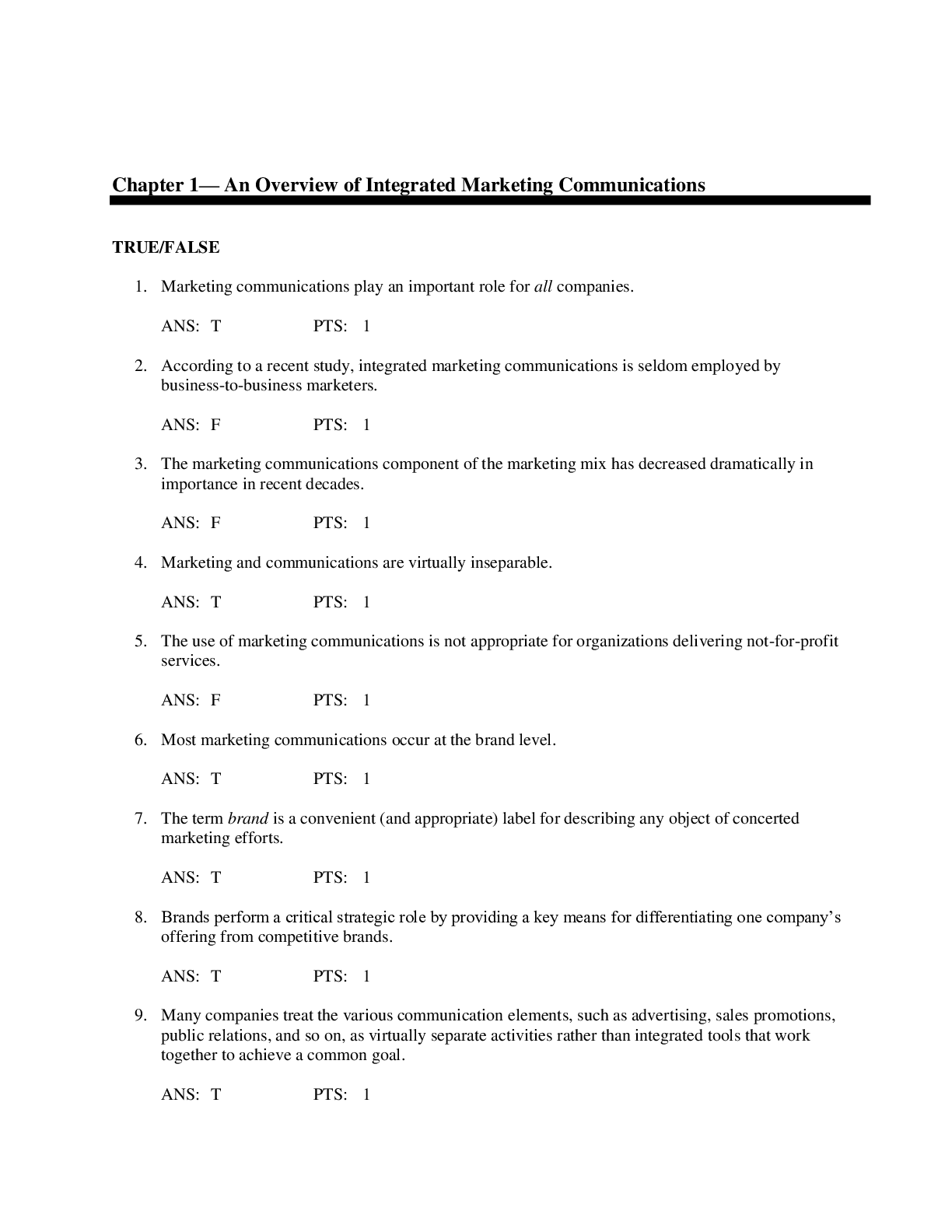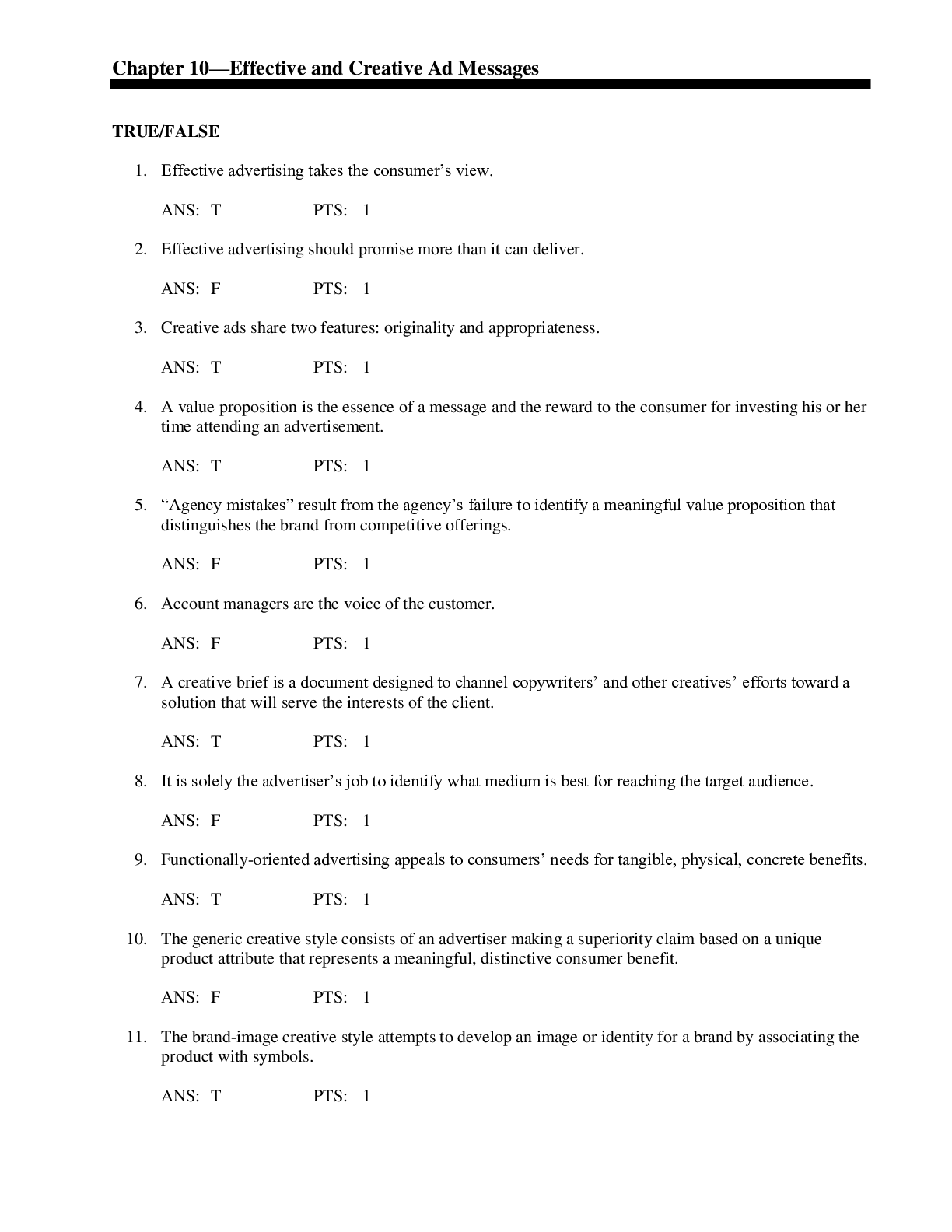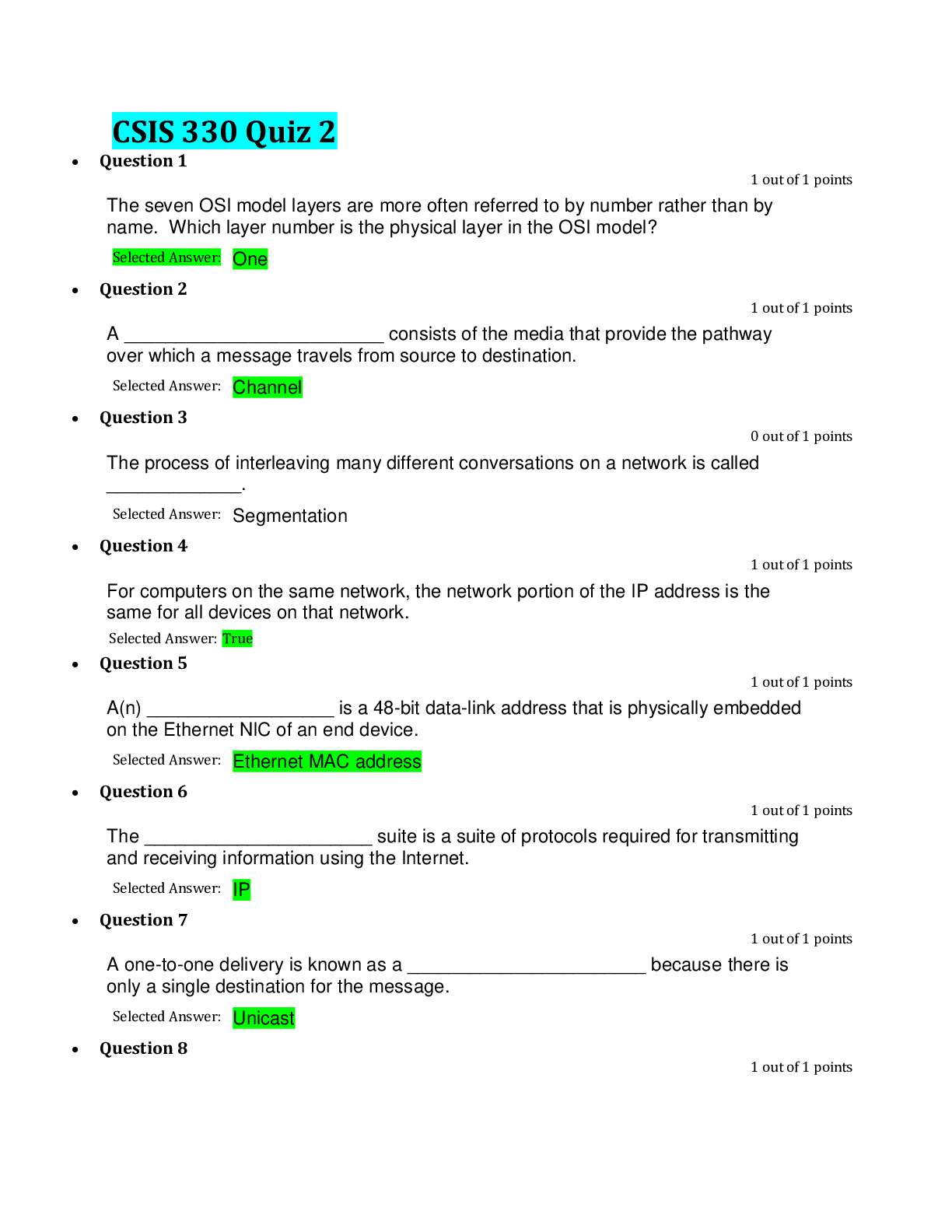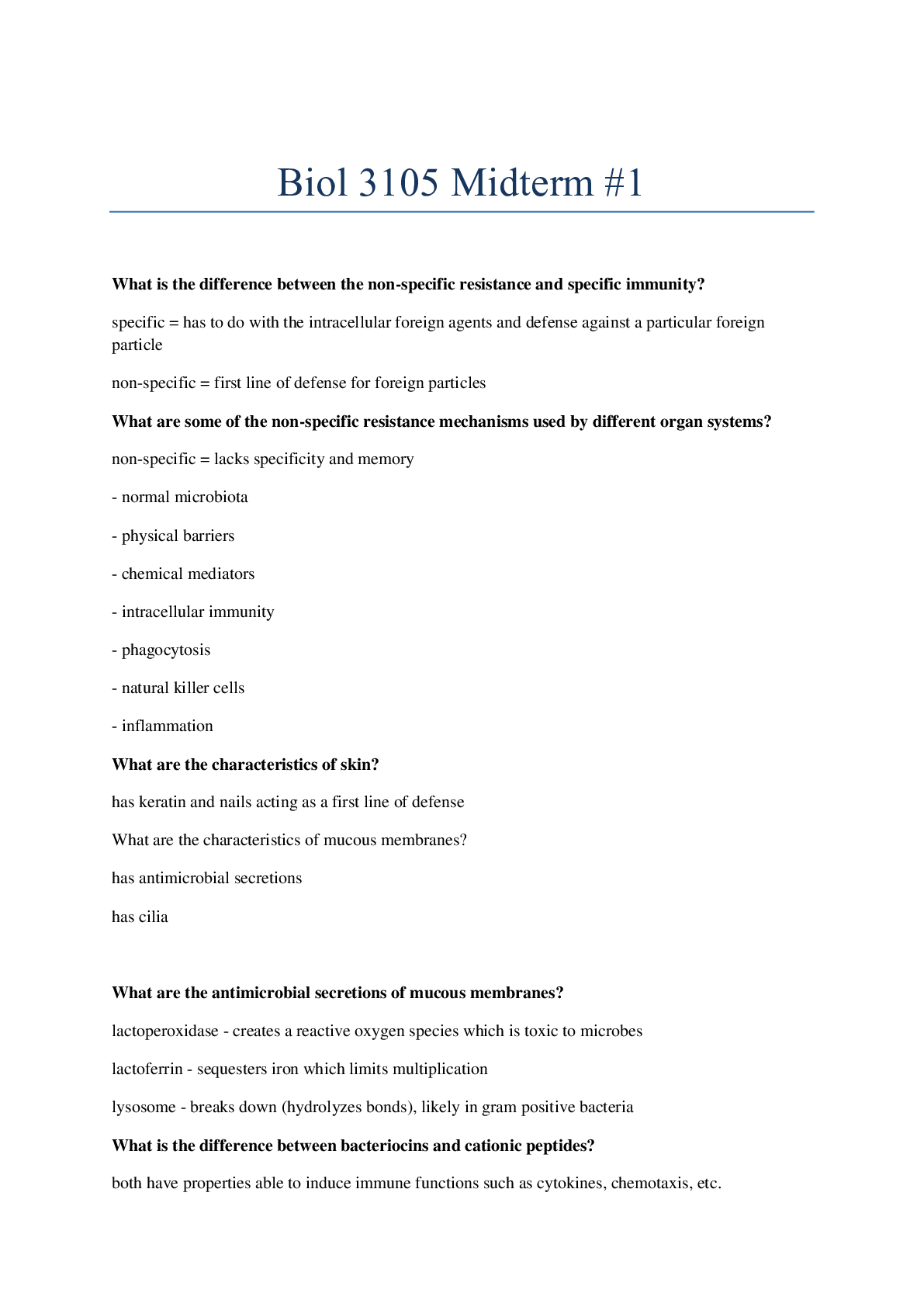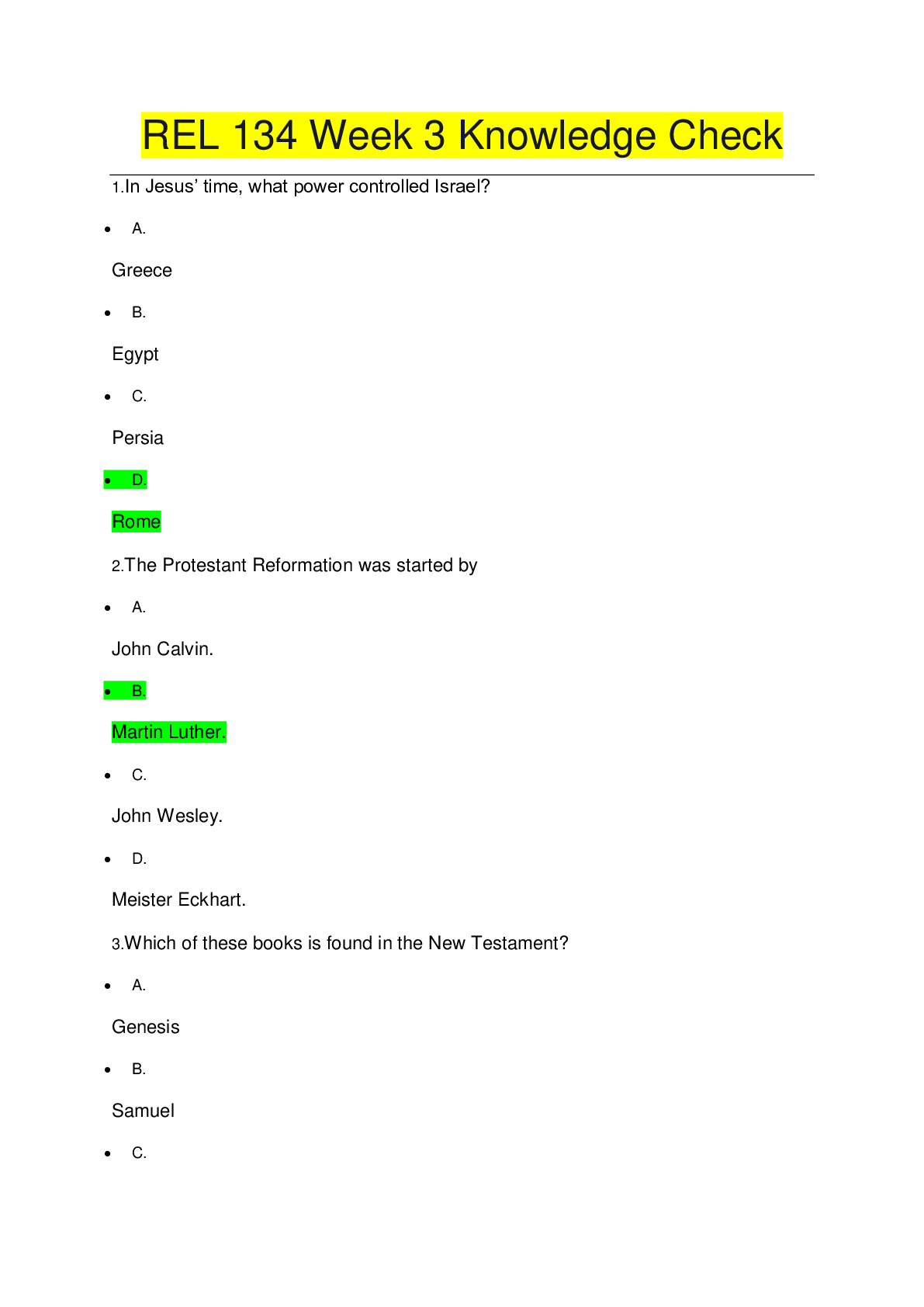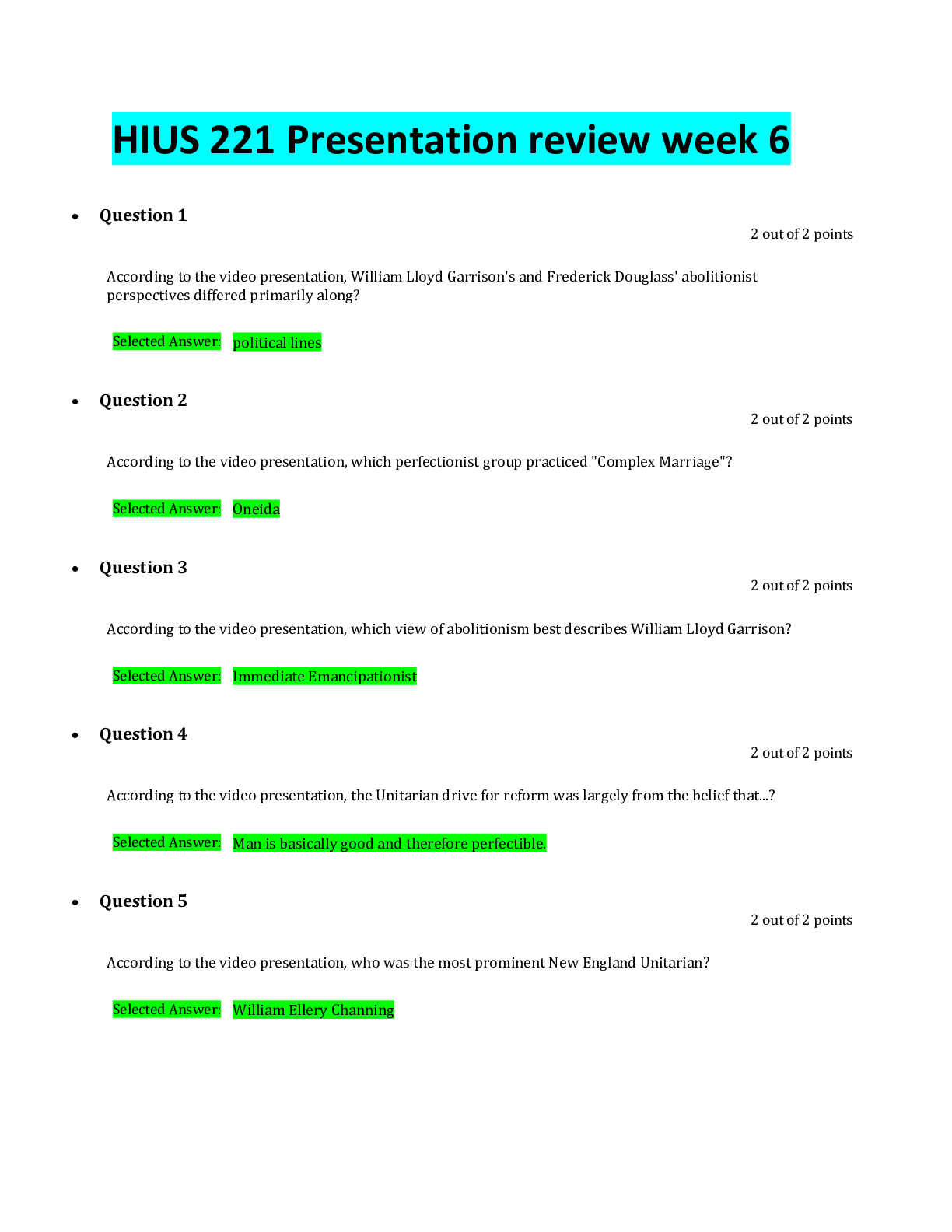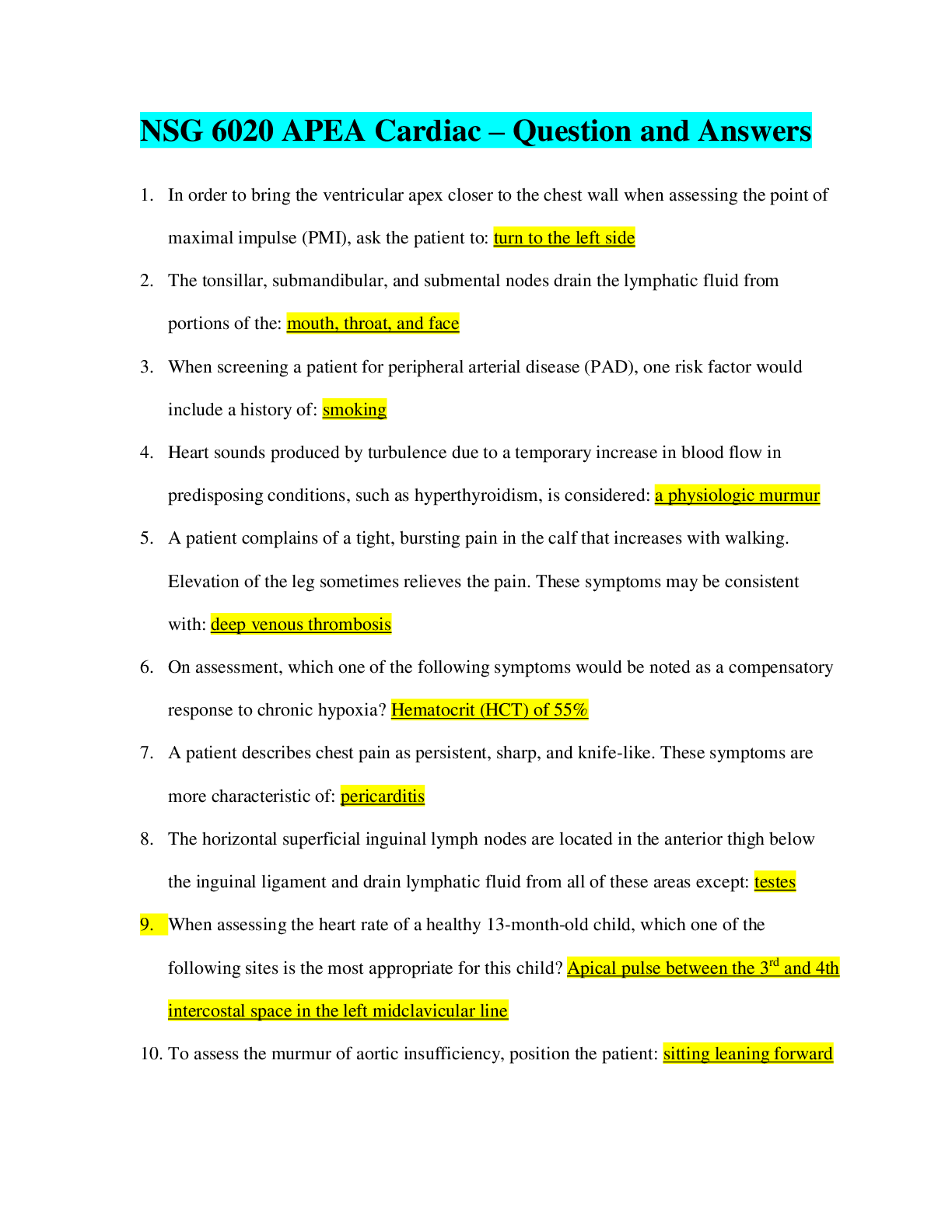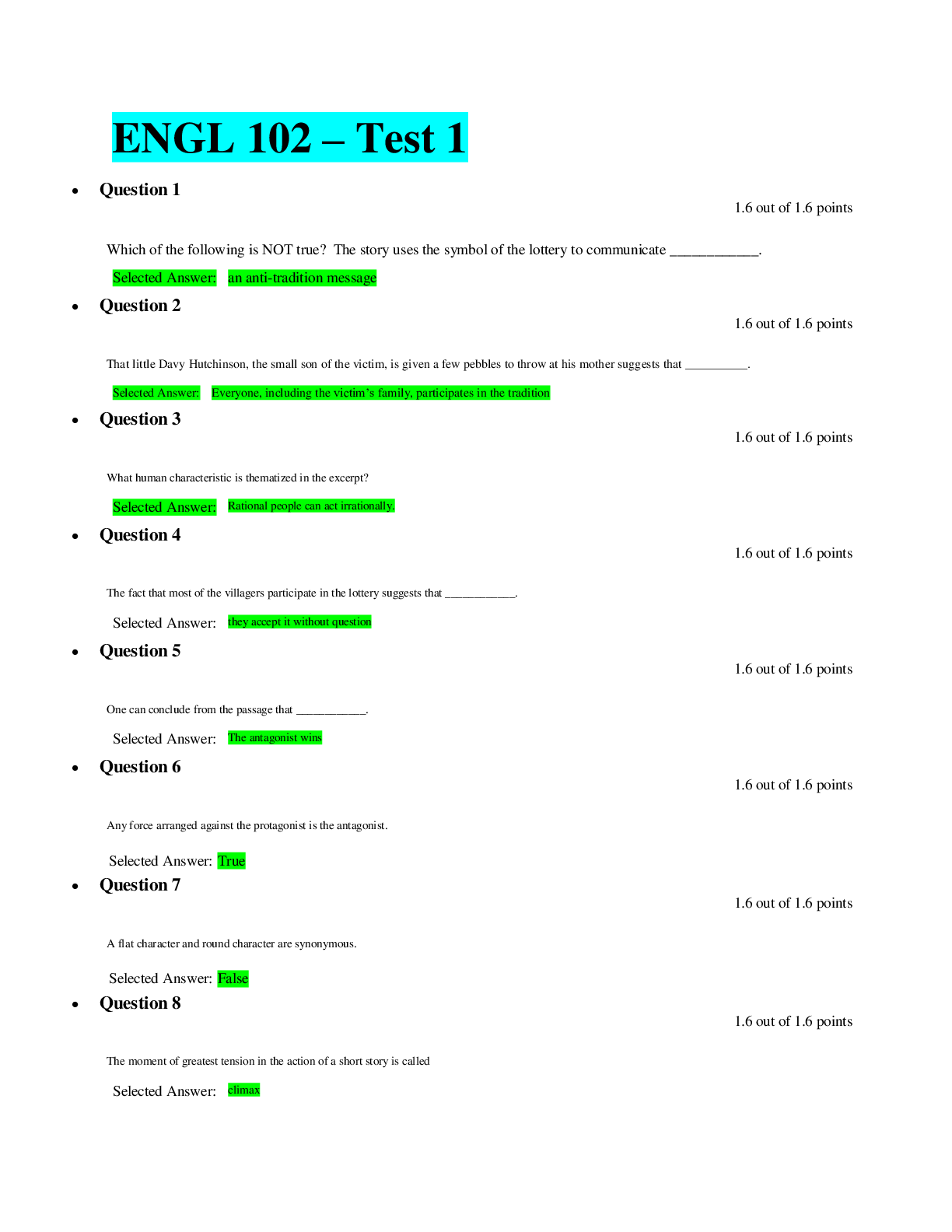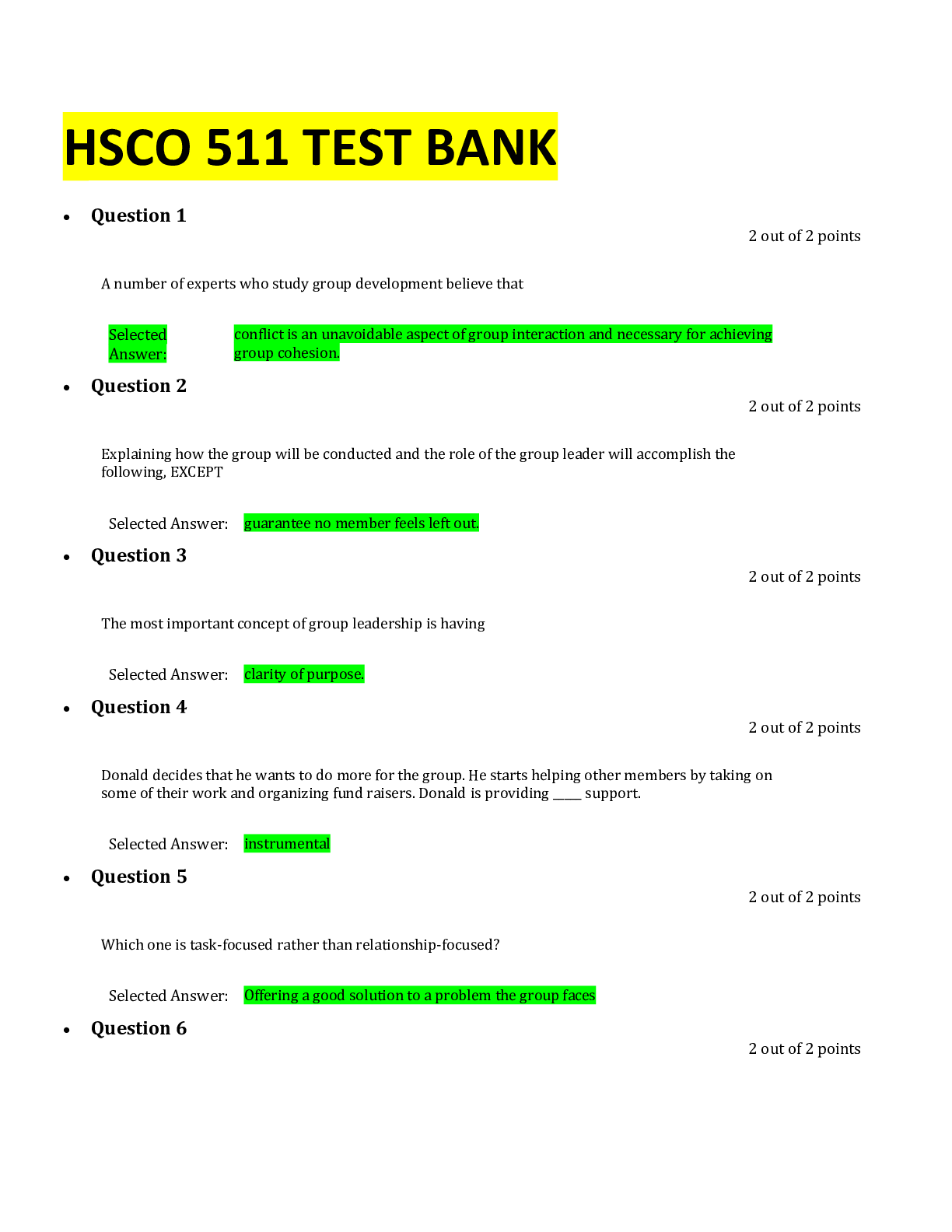Business > QUESTIONS & ANSWERS > Chapter 09 Production and Operations Management of Goods and Services Questions and Answers | ALL AN (All)
Chapter 09 Production and Operations Management of Goods and Services Questions and Answers | ALL ANSWERS CORRECT
Document Content and Description Below
Chapter 09 Production and Operations Management of Goods and Services 1. Currently, manufacturing accounts for only around 70% of U.S. GDP. True False 2. The 2008 recession greatly affected the st... ate of manufacturing in the U.S., resulting in a slow down in production and the loss of jobs. True False 3. The Green Movement has had a large affect on the service industry, but only a negligible affect on manufacturing. True False 4. Prior to the recession of 2008-2009, foreign investment bought steel plants in the U.S. and planned to run them at capacity. These and other manufacturing sites were keeping the growth in manufactured products at about 4% per year. True False 5. One key to the resurgence of U.S. firms as world-class competitors has been the implementation of a focus on quality. True False 6. Evidence suggests that U.S. manufacturing firms can no longer compete against the best firms in the rest of the world. True False 7. American manufacturers have emphasized continuous improvement as one strategy for regaining a competitive advantage in the manufacturing sector. True False 1 8. In order to be more competitive globally, production techniques such as enterprise resource planning and lean manufacturing are being used by American manufacturers. True False 9. To strengthen its manufacturing base, the U.S. will need to continue to innovate. True False 10. The U.S. is still manufacturing intensive. Only 25% of U.S. jobs come from the service sector. True False 11. Companies such as IBM prefer to stay the course and continue to compete by selling products instead of services. True False 12. Since U.S. manufacturing competes on price throughout the world, innovation plays a very small part in the U.S. economy. True False 13. U.S. businesses are known for their creativity and their ability to implement change. True False 14. The main reason for the recent resurgence of American manufacturing firms has been the quotas and tariffs imposed by the U.S. government in an attempt to protect domestic firms from cheap imports. True False 15. As the service industries became a larger part of U.S. GDP, companies have become more concerned about measuring productivity in the service sector. True False 2 16. U.S. manufacturers are focusing on quality as a way to become more competitive globally, assuming that cost is not an issue. True False 17. Although important, the Green Economy will do little to add value to the U.S. economy. True False 18. Casey and Kevin are scanning the "All Things Green" magazine trying to get some green ideas they can incorporate into their business. The problem with going green, however, is that quality tends to decrease, and it is difficult to incorporate contemporary operations management techniques with "green" ideas. True False 19. In the past, production management was about using the factors of production to create finished goods. True False 20. Operations management converts resources into goods and services. True False 21. In the process of operations management, a firm transforms resources such as raw materials, supplies, and even human resources into goods and services. True False 22. The service sector of the U.S. economy offers many jobs, but very few of them are considered high wage occupations. True False 23. Firms that specialize in accounting, finance, and management consulting are all part of the service sector. True False 3 24. Operations management involves inventory management, quality control, and production scheduling. True False 25. Manufacturing firms focus exclusively on the production of goods and allow other firms to provide services. True False 26. In recent years, operations management has become more focused on providing services, because that is where the growth and profit potential is greatest. True False 27. Operations management in service industries is about creating a good experience for the customer. True False 28. Operations management moves from knowing the needs of consumers to actually satisfying those needs. True False 29. In service industries such as hotels, quality management training is important to ensure that all employees are "certified" in their positions. True False 30. Education and training are less important to workers in the service sector than to workers who have jobs in the manufacturing sector. True False 31. The quality standard for service industries such as luxury hotels is meeting the customers' requests. True False 32. Service businesses know that in order to delight customers they must be able to anticipate their needs. True False 4 33. One important issue with respect to managing the operation of a business is to make certain that customers leave feeling as though they had a good experience with your service and with your company in general. True False 34. Manufacturing companies are concerned with production management, while service companies are concerned with operations management. True False 35. An important strategy in operations management is using technology to anticipate customer needs. In the hotel industry, this is known as guest-recognition services. True False 36. Operations management transforms resources into goods and services, such as a landscape company that utilizes equipment, labor, and materials to develop a landscape. Managing this operation may also involve maintenance services. True False 37. Jason recently graduated with a degree in operations management from a respected university. The knowledge he gained and skills he developed while obtaining this degree could make him an attractive employee for either a manufacturing firm or a service firm. True False 38. Justin Tyme is a manager at Elastic Plastic, Inc. His duties include production scheduling and keeping tabs on the company's inventory. These activities suggest that Justin is involved in promotions management. True False 39. While going through the line at the local grocery store, the clerk asks you if you found everything you needed, as she continues to scan the goods you are planning to purchase. At the end of the scan, a coupon emerges that you can use on future purchases of a product you have just purchased. In reviewing the key concepts from Chapter 9, you would consider this action, the store's management of its labor. True False 5 40. Marci Costas is majoring in operations management at Brunau University. Unfortunately, the evolution of the U.S. from a manufacturing-oriented to a service-oriented economy means that Marci will probably find few job openings in her field of study. True False 41. When firms successfully produce products, they create form utility. True False 42. Only firms in the manufacturing sector can create true form utility. True False 43. The three basic requirements of production are: (1) creating a finished good (2) making sure you created it at the lowest cost possible, and (3) selling it. True False 44. The value added by the creation of finished goods and services from inputs is called ownership utility. True False 45. Process manufacturing refers to combining components and raw materials to make a product. True False 46. Process manufacturing physically or chemically alters materials to create finished goods. True False 47. An assembly process involves physically or chemically manipulating raw materials to create a product. True False 48. A continuous production process is characterized by long production runs that turn out finished goods over time. True False 6 49. Intermittent production processes are characterized by short production runs and frequent changes of machinery in order to produce different products like customized furniture. True False 50. Contemporary manufacturers in the U.S. lack the flexibility to use intermittent production processes. True False 51. One drawback of intermittent production processes is that they tend to be much slower than continuous processes. True False 52. The production process requires inputs, controls, and outputs. True False 53. Mass production techniques allowed firms to respond quickly to the individual needs of consumers. True False 54. One of the reasons mass production techniques lost favor is that, despite their ability to keep costs relatively low, mass production lacks flexibility. True False 55. The ability to integrate computers into the design and manufacture of products has had the greatest impact on production techniques in recent years. True False 56. CAD/CAM has made it possible to custom-design products to meet the tastes of small markets with very little increase in costs. True False 7 57. CAD systems allow designers to work in three dimensions. True False 58. Despite its early promise, computer-aided design has not met with much success in increasing productivity. True False 59. The purpose of computer-integrated manufacturing (CIM) is to unite computer-aided design with computeraided manufacturing. True False 60. The advantage of computer integrated manufacturing software is that it allows computer aided design machines to communicate directly with computer aided manufacturing machines. True False 61. So far, the high cost of CAD/CAM techniques has limited their use to large, expensive manufactured goods such as automobiles. True False 62. Flexible manufacturing systems use machines that are designed to do a multitude of tasks so that they can produce a variety of goods. True False 63. A disadvantage of flexible manufacturing systems is that they usually require a great deal of labor because machines are rarely capable of handling a wide variety of tasks. True False 64. One way to compete with cheap labor is to use robots. True False 8 65. Lean manufacturing is a strategy of producing standardized products that have no frills or extra features in order to keep prices low. True False 66. Companies that achieve lean manufacturing use less of everything (raw materials, labor, etc.) to produce the same amount of products. True False 67. Technological improvements are largely responsible for the increase in productivity and efficiency of U.S. plants. True False 68. The higher productivity of U.S. plants makes it possible to pay higher wages. True False 69. Mass customization is tailoring products to meet the needs of individual customers. True False 70. Mass customization is a strategy of convincing customers to choose from a relatively small number of alternatives in order to achieve the efficiencies of mass production. True False 71. While mass customization works well for producers it is not used in the service sector. True False 72. Actually, it is much easier to custom-design service programs than it is to custom-make goods. True False 73. Speeding up the process of responding to consumer wants and needs is a key to global competitiveness. True False 9 74. A fast-changing plant needs a fast-moving employee base to achieve maximum productivity. True False 75. Companies that employ lean manufacturing and flexible manufacturing produce better quality products, but have costlier production lines. True False 76. When a company has the ability to produce the same amount of goods with only half the floor space and half the labor that it used in the past, the firm is practicing flexible manufacturing. True False 77. Improvements in technology have significantly increased the quality of products, as well as helped reduce costs. True False 78. Manufacturers use CAM (computer aided manufacturing) to create three-dimensional designs of products before they are built. True False 79. Mass customization is not exclusive to product intensive businesses. Service businesses have learned how to use mass customization to serve their customers. True False 80. Businesses that provide services typically cannot use mass customization because services are not tangible products that can be customized. True False 81. Process manufacturing involves t [Show More]
Last updated: 1 year ago
Preview 1 out of 176 pages
Instant download

Buy this document to get the full access instantly
Instant Download Access after purchase
Add to cartInstant download
Reviews( 0 )
Document information
Connected school, study & course
About the document
Uploaded On
Sep 10, 2021
Number of pages
176
Written in
Additional information
This document has been written for:
Uploaded
Sep 10, 2021
Downloads
0
Views
88





.png)

.png)






